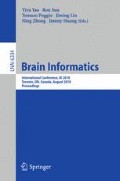Abstract
Problem representation is one of the key factors in problem solving. According to previous studies, PPC (Posterior Parietal Cortex) is critical for problem representation. Whether does problem expression form affect problem representation? What are the cognitive role of PPC in representation? In order to answer these questions, a fMRI experiment was performed in this study to examine the role of PPC in problem solving. It was a 2 × 2 designed experiment with two 2-level factors: task complexity (one-step and two-steps) and expression form (digits and symbols). In a digital task, 4 digits are provided in the initial grids, while 4 symbols of poker are provided in a symbolic task. In a task of one-step, participants only need one time rules retrieving to get the target answer, while in a task of two-steps, participants need two times rules retrieving to get the answer of target after getting the answer of a bridging location. The results of fMRI show that PPC activated significantly. The further analysis shows that there is a positive correlation between the activation intensity of PPC and task complexity, but the correlation between the activation intensity of PPC and task expression is not significant. According these results, we infer that PPC plays an important role in problem representation, maybe this representation is a high level abstraction.
Access this chapter
Tax calculation will be finalised at checkout
Purchases are for personal use only
Preview
Unable to display preview. Download preview PDF.
References
Newell, A., Simon, H.A.: Human problem solving. Prentice-Hall, New Jersey (1972)
Simon, H.A.: Search and reasoning in problem solving. Artificial Intelligence 21, 7–29 (1983)
Newell, A.: Unified Theories of Cognition. Harvard University Press, Cambridge (1990)
Anderson, J.R.: ACT: A simple theory of complex cognition. American Psychologist 51, 355–365 (1996)
Fincham, J.M., Carter, C.S., Vincent, V.V., et al.: Neural mechanisms of planning: A computational analysis using event-related fMRI. PNAS 99(5), 3346–3351 (2002)
Anderson, J.R., Albert, M.V., Fincham, J.M.: Tracing problem solving in real time: fMRI analysis of the subject-paced Tower of Hanoi. Journal of Cognitive Neuroscience 17(8), 1261–1274 (2005)
Baker, S.C., Rogers, R.D., Owen, A.M., et al.: Neural systems engaged by planning: a PET study of the Tower of London task. Neuropsychologia 34, 515–526 (1996)
Dagher, A., Owen, A.M., Boecker, H., et al.: Mapping the network for planning: A correlational PET activation study with the Tower of London task. Brain 122(10), 1973–1987 (1999)
Odile, A., Henk, J.G., Barkhof, F., et al.: Fron-tostriatal system in planning complexity: a parametric functional magnetic resonance version of Tower of London task. NeuroImage 18, 367–374 (2003)
Wagner, G., Koch, K., Reichenbach, J.R., et al.: The special involvement of the rostro-lateral prefrontal cortex in planning abilities: An event-related fMRI study with the Tower of London paradigm. Neuropsychologia 44, 2337–2347 (2006)
Newman, S.D., Carpenter, P.A., Varma, S., Just, M.A.: Frontal and parietal participation in problem solving in the Tower of London: fMRI and computational modeling of planning and high-level perception. Neuropsychologia 41, 1668–1682 (2003)
Shallice, T.: Specific impairments of planning. Philosophical Transactions of the Royal Society London[Biol.] 298, 199–209 (1982)
Owen, A.M., Downes, J.D., Sahakian, B.J., et al.: Planning and spatial working memory following frontal lobe lesions in man. Neuropsychologia 28, 1021–1034 (1990)
Rasser, P.E., Johnston, P., Lagopoulos, J., et al.: Functional MRI BOLD response to Tower of London performance of first-episode schizophrenia patients using cortical pattern matching. NeuroImage 26, 941–951 (2005)
Lazeron, R.H., Rombouts, S.A., Machielsen, W.C., et al.: Visualizing brain activation during planning: the tower of London test adapted for functional MR imaging. American Journal of Neuroradiology 21, 1407–1414 (2000)
Schall, U., Johnston, P., Lagopoulos, J., et al.: Functional brain maps of Tower of London performance: a PET and fMRI study. NeuroImage 20, 1154–1161 (2003)
Bustini, M., Stratta, P., Daneluzzo, E., et al.: Tower of Hanoi and WCST performance in schizophrenia: problem-solving capacity and clinical correlates. Journal of Psychiatric Research 33, 285–290 (1999)
Whitlock, J.R., Sutherland, R.J., Witter, M.P., et al.: Navigating from hippocampus to parietal cortex. PNAS 105(39), 14755–14762 (2008)
Todd, J.J., Marois, R.: Posterior parietal cortex activity predicts individual differences in visual short-term memory capacity. Cognitive, Affective, & Behavioral Neuroscience 5(2), 144–155 (2005)
Anderson, J.R.: How Can the Human Mind Occur in the Physical Universe? Oxford University Press, USA (2007)
Andersen, R.A., Snyder, L.H., Bradley, D.C., Xing, J.: Multimodal representation of space in the posterior parietal cortex and its use in planning movements. Annual Review of Neuroscience 20, 303–320 (1997)
Medendorp, W.P., Goltz, H.C., Crawford, J.D., Vilis, T.: Integration of target and effector information in human posterior parietal cortex for the planning of action. Journal of Neurophysiology 93(2), 188–199 (2005)
Author information
Authors and Affiliations
Editor information
Editors and Affiliations
Rights and permissions
Copyright information
© 2010 Springer-Verlag Berlin Heidelberg
About this paper
Cite this paper
Xiang, J., Qin, Y., Chen, J., Zhou, H., Li, K., Zhong, N. (2010). The Role of Posterior Parietal Cortex in Problem Representation. In: Yao, Y., Sun, R., Poggio, T., Liu, J., Zhong, N., Huang, J. (eds) Brain Informatics. BI 2010. Lecture Notes in Computer Science(), vol 6334. Springer, Berlin, Heidelberg. https://doi.org/10.1007/978-3-642-15314-3_40
Download citation
DOI: https://doi.org/10.1007/978-3-642-15314-3_40
Publisher Name: Springer, Berlin, Heidelberg
Print ISBN: 978-3-642-15313-6
Online ISBN: 978-3-642-15314-3
eBook Packages: Computer ScienceComputer Science (R0)

